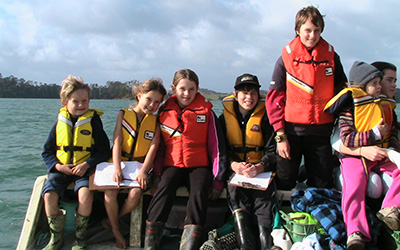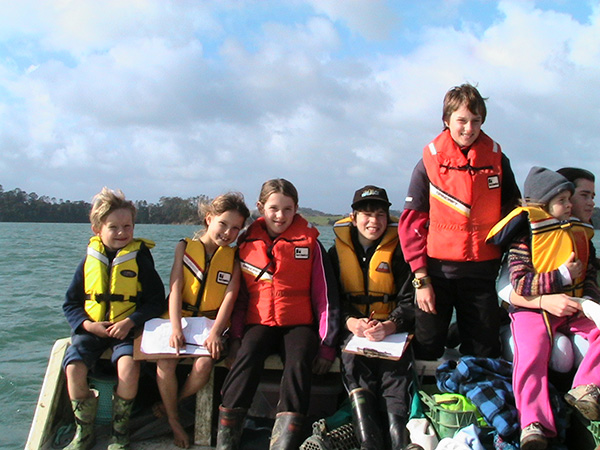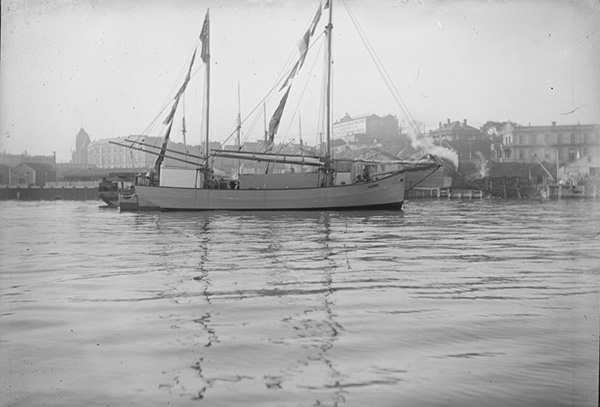Exploring a plan-b Pūhoi Rivermouth ferry


Oyster-Barge Boosted Riparian Planting: Before oyster farmers were obliged to have their barges certificated, they were happy to provide transport to otherwise inaccessible planting sites, such as the one in Dyers Creek that these school students are departing in 2007, during the first few years of the Mahurangi Action Plan. image Auckland Regional Council
With a long-term solution calculated to cost $2 million, it is time to consider a plan b. This not to suggest that $2 million is too rich to realise the magnificent potential of the Mahurangi Coastal Trail. It is too much, however, given the several significant untested aspects of the concept.
The fundamental untested assumption is demand. While there is every reason to believe, in this instance, that if-we-build-it-they-will-come will apply in spades, a trial period would allow for a far more robust gauging of demand, and would simultaneously provide an unparalleled opportunity to both promote the concept and, recruit support for it.
Aside from demand, the major unknown is the viability of a reaction ferry in a tidal environment. Known reaction ferries operate in rivers flowing reliably in one direction only. At the Pūhoi River Mouth, flow in one direction diminishes to nothing and a period of slack water prevails until the flow fills in from the opposite direction. The best way to operate in this challenging environment can either be assessed through real-world trials or by modelling, but to convincingly model such a complex environment in a sufficiently wide combination of current and wind strengths would require the budget of an America’s Cup campaign—much cheaper, more convincing, not to mention more fun, to conduct life-sized.
As luck would have it, Mahurangi Action was independently contemplating the building of a small barge that would admirably meet the criteria for a river-mouth-ferry test bed. Required for all manner of regatta, riparian planting, educational duties, and for conveying dignitaries, politicians, and council officers to view points of concern or interest. One such expedition, in 2003, in the then semiretired oyster barge Pooh, led to Auckland Regional Council and Rodney District Council agreeing to build the boardwalk between the landing and Scott Homestead, in time for the Mahurangi Regatta Ball, the grand finale of Warkworth’s 150th celebrations. Such a vessel could ably serve in the short term to test the various operational options already identified, and the waters in respect to demand.

Scow Sans Scow Bow: Lacking a clear image of the Vesper, Vindex or Vixen, the Lena, similarly built by Charles Bailey, or Bailey and Lowe, sporting the more sophisticated bow of those build for the v-enthusiastic Biddock brothers, which is more suited to smaller scows lacking the muscle to punch a New Zealand-style scow bow through a Hauraki Gulf chop. Bailey and Lowe’s yard is at the extreme right of the image. image Sir George Grey Special Collections | Auckland Libraries
As the father of the river-mouth ferry, the oyster barge would be an apt and noble progenitor. The Mahurangi Harbour literally seeded New Zealand’s oyster-farming industry, all spat being caught in Huawai Bay on government-owned racks and transported to farms in the Auckland, Northland, and Coromandel regions. Mahurangi was also where the Pacific oysterCrassostrea gigas suddenly appeared and rapidly subjugated the slower growing indigenous rock oysterSaccostrea glomerata. Punts and barges are something that Mahurangi Action knows a bit about, with current committee members collectively having more than a century of experience between them.
Oyster barges, and barges typically, have a vice that cannot be tolerated on the trial river-mouth ferry. Long-term, the ferry would possibly operate from pontoons to allow passengers to embark and disembark quickly and efficiently. In the short term, however, the ferry will deploy hinged gangways, and passengers will embark and disembark from the beach on either shore. This expedient, as well as deferring the decision as to the long-term need for pontoons, will have a much lower landscape and visual impact on the idyllic river mouth environment. However, with the barge close to the shore, and people in close proximity, the hard chine typical of such craft presents an unforgiving hazard should a person’s foot be under the chine when it impacts with the beach, when many tonnes of crushing force can be applied—not only a vice, a quick-acting vice! Fortunately, rather than a rectangular chine, the barge can be designed with a chine of angled or radiused sectionthe former is termed a double chine, to provide a generous kick space. This has the added virtue of markedly improving the waterflow around the chine.
A series of cattle scowsNew Zealand sailing barges, reputed to be faster than their cruder hard-chine scow-bowed cousins, were built with generously-rounded chines. As a river-mouth ferry ancestor, the scow would carry even greater heritage gravitas, as well as that particular form being efficient and highly manoeuvrable—the latter being something that catamarans inherently are not. Meanwhile, a significant advantage of the barge form generally, when landing and boarding passengers—or cattle!—is that the deck level can be kept considerably lower than that of a catamaran, thus keeping gangway incline to a minimum.
A further major benefit of proceeding via a low-cost barge testbed is that a short-term resource consent, for that operation, can be much more readily obtained, and at less expense, than for a long-term one. In fact, there is a very real risk that a long-term consent would not be forthcoming. If the operation was to have already proved itself, only the detail of the long-term consent would remain to be determined.
And the Mahurangi is that much closer to having a barge dedicated to its myriad needs.

Good short-term alternative. Should prove the value of the project.
I agree Mike. I think the plan b is well-conceived, and is a very realistic interim solution.
If the plan a were to fail to attract the people, or to have engineering problems, the whole concept could be dubbed an expensive folly and abandoned, thus condemning not only the ferry concept but the coastal trail concept.
But if a simpler plan b, with a lower payback point and a shorter consent–implementation period, were to succeed to the point where happy punters demanded more or better ferry services, plan a could again be floated!
Good move Cimino.